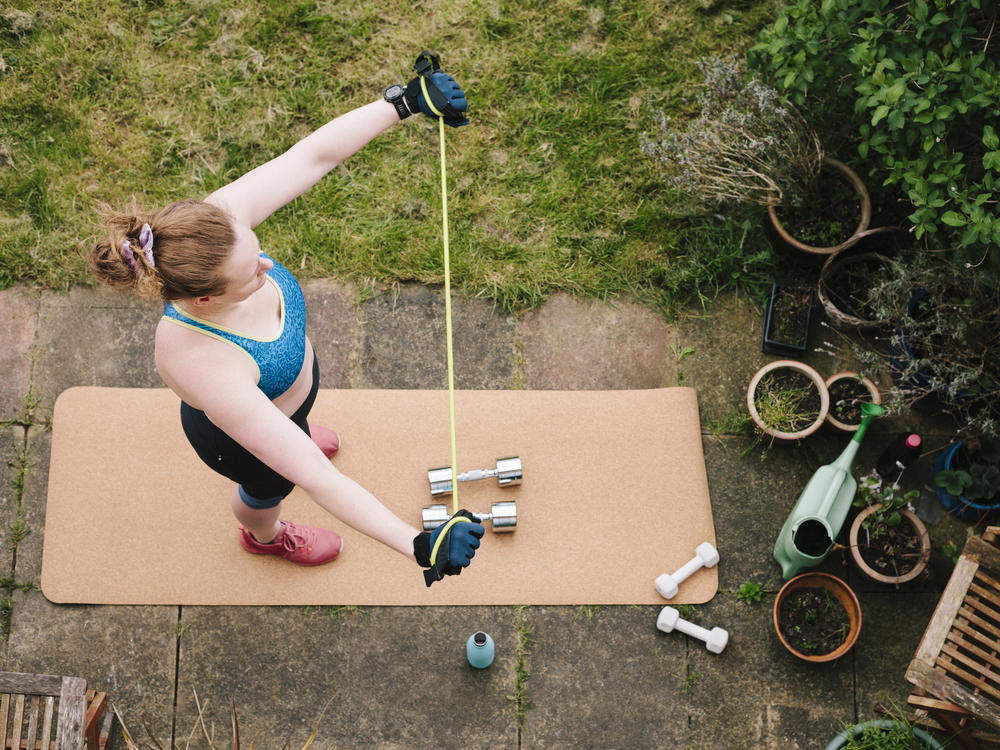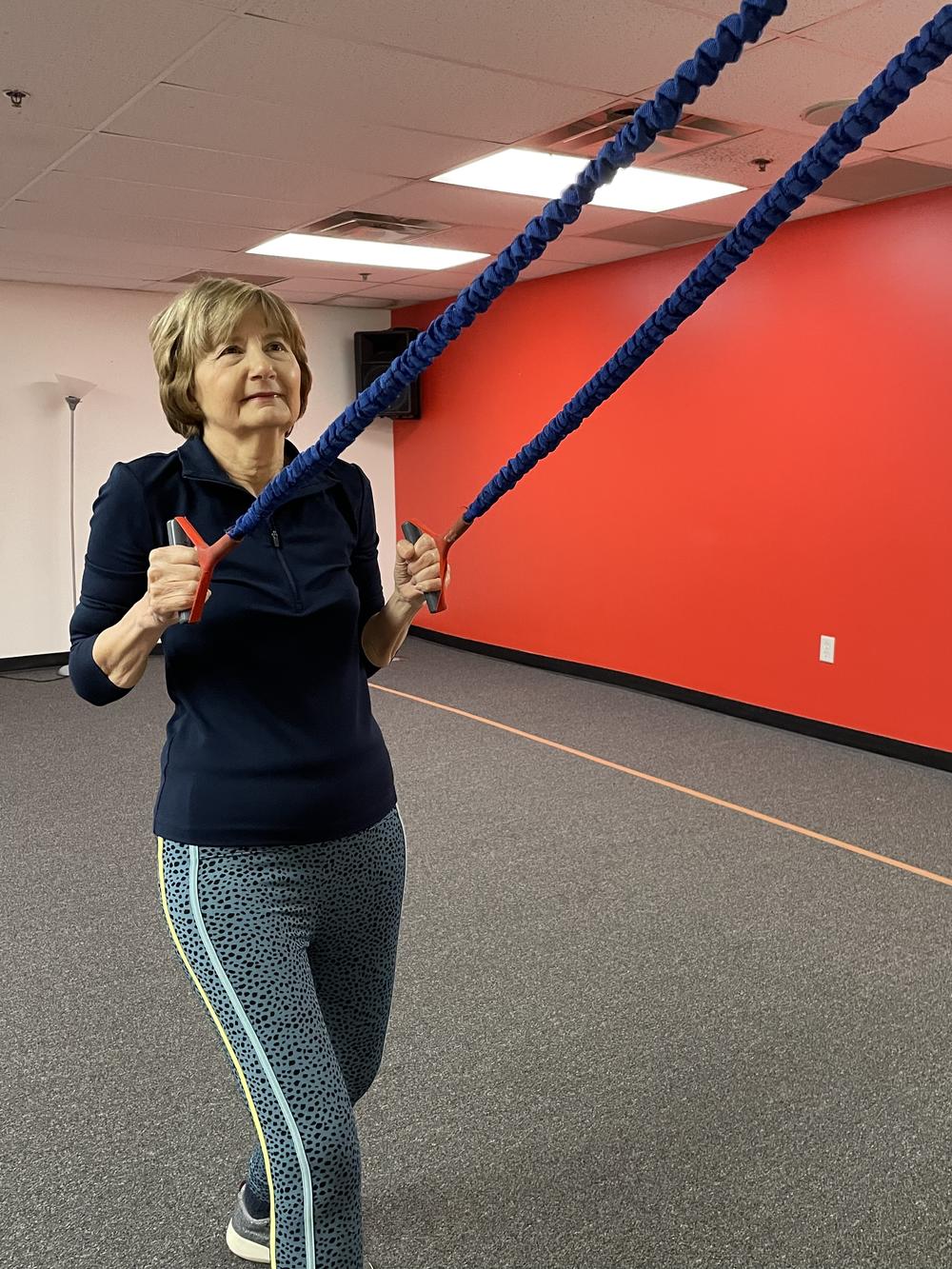Section Branding
Header Content
Women who do strength training live longer. How much is enough?
Primary Content
Resistance training does more than help us build strong muscles.
A new study finds women who do strength training exercises two to three days a week are more likely to live longer and have a lower risk of death from heart disease, compared to women who do none.
"We were incredibly impressed by the finding," says study author Martha Gulati, who is also the director of preventive cardiology at Cedars Sinai in Los Angeles.
Of the 400,000 people included in the study, only 1 in 5 women did regular weight training. But those who did, saw tremendous benefits.
"What surprised us the most was the fact that women who do muscle strengthening had a reduction in their cardiovascular mortality by 30%," Gulati says. "We don't have many things that reduce mortality in that way."
Strength training is also good for bones, joints, mood and metabolic health. And at a time when many women focus on aerobic activity and hesitate to do weight training, the findings add to the evidence that a combination of both types of exercise is powerful medicine. "Both should be prescribed," Gulati says.
The findings are part of a larger study, published in The Journal of the American College of Cardiology, which evaluated the differences in the effects of exercise between men and women.
While the study finds that even small doses of exercise are beneficial for everyone, the data show that women need less exercise than men to get the same gains in longevity.
Women who did moderate intensity exercise, such as brisk walking, five times a week, reduced their risk of premature death by 24%, compared to 18% for men.
"The take home message is – let's start moving," says Eric Shiroma, a prevention-focused researcher at the National Heart, Lung, and Blood Institute, part of the National Institutes of Health, which provided grant support for the research..
It's not exactly clear what drives the variance between sexes, but there are physiological differences between men and women, and differences in heart disease risks, too.
People born female have less muscle and lower aerobic capacity in general. Also, women have more capillaries feeding part of their muscles, Shiroma says. The findings show women need to do less exercise to change their baseline of aerobic and muscular strength. "It might be that this relative increase in strength [in women compared to men] is what's driving this difference in benefit," he says.
The results show a little can go a long way. "The benefits start as soon as you start moving," Shiroma says.
It's increasingly common to see female weight lifters and body builders on social media, and many gyms and work-out studios now incorporate weight training into many of their classes and offerings. But, given that about 80% of women in the study said they don't participate in regular weight training, there's still a lot of hesitancy.
"I was always the awkward one in gym class back in school days," says Ann Martin, 69, of Wilmington, Del. She shied away from gyms and weight-training machines. Martin has always been a walker, but she realized she needed to build more strength, so last year she started working out with a trainer to learn how to use the equipment. "It's fun now," she says. "I can feel my muscles getting stronger."
Strength training can be intimidating, Shiroma says. "But it's not all bodybuilders trying to lift super amounts of weight." He says there are many ways to incorporate resistance training into your life.
All activities that require your muscles to work against a weight or force count as strength training. This includes the use of weight machines, resistance bands or tubes, as well as all the many ways we can use our own body weight, as we do with push-ups and squats.
The findings of this new study fit with the Physical Activity Guidelines for Americans, which recommend that adults get a minimum of 2.5 hours of moderate-intensity exercise a week, that's about 30 minutes, most days of the week. The guidelines also call for doing strength-based activities at least two days a week.
The increase in lifespan can likely be explained in part, by the well-being that comes from the other hidden benefits. Here are 5 ways building strength can boost good health.
1. Strength training helps protect joints.
Physical therapists often recommend resistance training for patients with knee and hip pain. "Strength training protects joints, resulting in less stress through the body," says Todd Wheeler, a physical therapist at MedStar Health Physical Therapy in Washington, D.C. "If joints could talk, they would say 'It's not my fault I'm irritated," Wheeler says. They'd blame it on weak muscles. He says strong muscles support the joints, which can help decrease joint pain. Wheeler recommends starting small and simply. For instance, try a few squats and table pushups. "Listen to your body and gradually increase intensity over time," he says.
2. Building muscle burns more calories
Aerobic exercise – such as running and cycling – typically burns more calories in real time compared to strength training. But people who weight train can get a boost in calorie burning over the long-term.
"When you're doing resistance training, you're building muscle. That muscle requires energy," says Bryant Johnson, a trainer who wrote The RBJ Workout. So, adding muscle mass can help people burn more calories.
Dr. Gulati also points to research that shows weight lifting and resistance training can help people lose more fat and improve body composition.
3. Resistance training protects against injuries and falls
As we've reported, millions of Americans, especially women, are under-muscled, and muscle mass is a predictor of longevity.
Since muscle mass peaks in our 30s and then starts a long, slow decline, we need to take steps to slow this down. If we don't do strength training exercise, we're more likely to become weak, increasing the risk of falls, which is the top cause of death among older adults in the U.S.
And since muscle loss - also known as sarcopenia - affects more than 45% of older adults in the U.S., "it's important to know about it and take steps to prevent it," says Richard Joseph, a wellness focused physician. He says strength training improves bone density which also protects against injuries and falls.
Joseph says people can get the biggest bang for their buck when they're starting out by focusing on lower body exercises that work big muscle groups in the legs.
4. Strength training helps control blood sugar
About 1 in 3 adults in the U.S. has prediabetes. Strength training can help control blood sugar by clearing glucose out of the bloodstream.
When we use our muscles during exercise, whether it's pushing, pulling, lifting or moving, they require more glucose for energy. This explains why exercise after meals can help control blood sugar.
And a recent study found strength training can be even more effective than aerobic activity in controlling blood sugar in people with diabetes.
5. Muscle building may help boost mood
A meta-analysis published in the medical journal JAMA Psychiatry in 2018, which included the results of more than 30 clinical trials, found a reduction in symptoms of depression among people who did weight training two times a week or more.
Strength training has also been shown to improve depressive symptoms in people at risk of metabolic disease. And, research shows strength training can tamp down anxiety, too.
Ann Martin says it makes sense that our moods improve when we move. "It gets your blood flowing," she says. "It feels good."
This story was edited by Jane Greenhalgh


